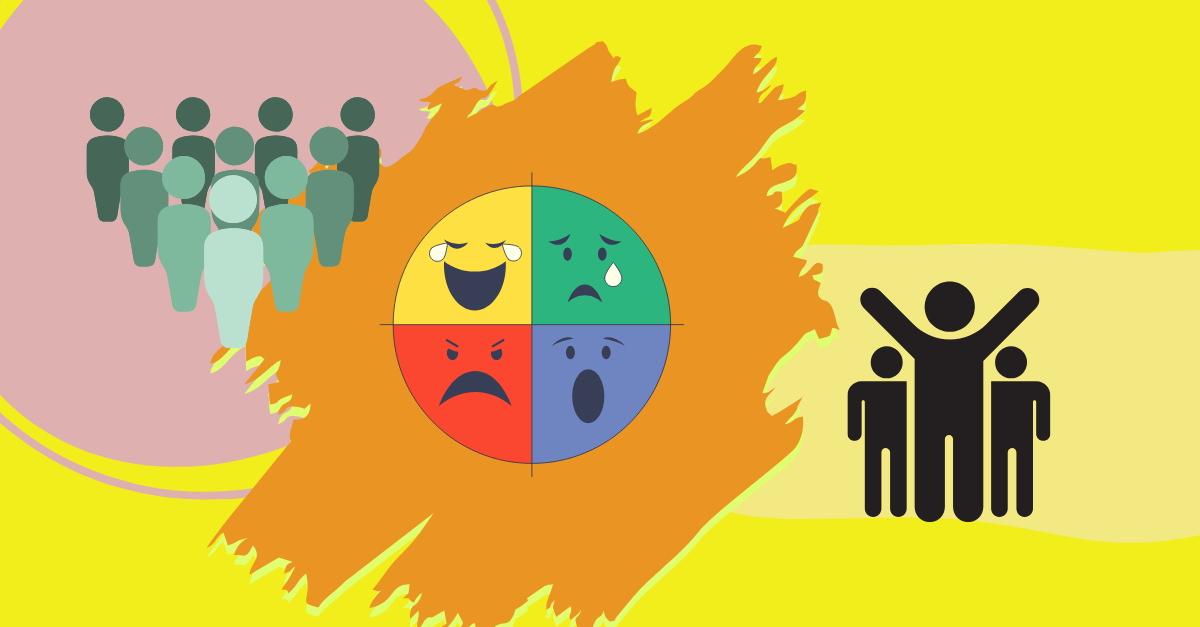5 mins read//
The scene centers on Jack, who manages projects for a successful internet company. He had to make a decision. Despite his excellent technical abilities, his staff was disengaged and frequently quarreled over ideas. One day, during a particularly heated meeting, a young programmer named Maya broke down in tears due to stress. Jack became aware of this situation and realized that, despite his exceptional ability to achieve results, he had failed to consider the emotional health of his staff.
Committed to changing the narrative, Jack made an effort to understand the emotions that shaped his team's relationships. He transformed not only his leadership style but also the team's morale by prioritizing empathy and self-awareness. As a result, teamwork flourished and output increased dramatically, suggesting that emotional intelligence could be the key to a productive workplace.
1. The Emotionally Available Workplace
Imagine having the new Jack in your office, where you are arriving at work where everyone is inspired, respected, and understood. Everyone is working together, disagreements are settled amicably, and everyone is working toward the same objective.
Effective use of emotional intelligence (EI) is possible, therefore this isn't just a utopian dream.
More than just a catchphrase in today's business world, emotional intelligence is a critical ability that can improve leadership efficacy and change workplace dynamics. The ability to identify, comprehend, and control our own emotions as well as those of others is included.
2. Understanding Emotional Intelligence
Self-awareness and empathy, two essential traits that can greatly enhance team performance and promote a healthy work environment, are at the core of emotional intelligence. Leaders may foster a culture of cooperation and adaptability by developing these abilities, enabling staff members to flourish and make significant contributions to the objectives of the company.
2.1. What is Emotional Intelligence?
The ability to recognize, regulate, and assess emotions in ourselves and others can be categorized in the field of emotional intelligence (EI). Self-awareness, which enables people to identify their emotions; self-regulation, which enables them to control their emotional reactions; motivation, which propels people toward objectives; empathy, which facilitates understanding and connection with others; and social skills, which improve interpersonal interactions, are the five fundamental components of this crucial ability. Stronger teamwork, better communication, and conflict resolution are all outcomes of developing emotional intelligence (EI), which eventually creates a more upbeat and effective atmosphere in both personal and professional contexts.
2.1.1. Self-Awareness: Understanding Your Feelings and Their Effects
Being self-aware entails being aware of our emotional triggers and how they affect our attitudes and actions at work. For workers, this entails being able to recognize emotions such as tension, irritation, or excitement and understanding how they can impact decision-making, interactions with coworkers, and general job performance. Employees who develop self-awareness are better able to control their reactions, build wholesome connections, and make the workplace healthier. In addition to improving individual well-being, this awareness fosters cooperation and teamwork, which results in more positive and productive working relationships.
2.1.2.Self-Regulation: Managing Emotions and Impulses
Controlling one's emotional reactions and impulses is a component of self-regulation. It encourages deliberate decision-making by allowing people to think things through before acting. One can remain composed in trying circumstances by engaging in mindfulness exercises and identifying triggers. Better emotional resilience results from effective self-regulation, which makes it possible to perform more consistently in both personal and professional contexts. This ability can be improved by methods like deep breathing, journaling, and goal-setting, which will ultimately lead to improved stress management and wellbeing.
2.1.3.Motivation: Harnessing Emotions to Pursue Goals
The drive that pushes people toward their objectives in the form of motivation is frequently powered by emotional energy. It entails drawing on uplifting feelings like zeal and desire to maintain tenacity in the face of difficulties. Creating meaningful goals, imagining triumph, and acknowledging minor victories are all good ways to boost motivation. People can develop a growth-oriented and achievement-promoting mentality by recognizing their intrinsic and extrinsic motivators. Having emotional intelligence is essential for sustaining motivation over time.
2.1.4.Empathy: Understanding the Emotional Makeup of Others
Deeper relationships and better communication are made possible by empathy, which is the capacity to identify and comprehend the feelings of others. It entails paying attention and acknowledging emotions, which promotes rapport and trust. Empathy training improves relationships with others and promotes teamwork in a variety of settings. People can improve social relations and better meet the needs of others by placing themselves in other people's shoes. Empathy may be strengthened by employing strategies like thoughtful listening and open-ended questioning, which fosters a more understanding and encouraging atmosphere.
2.1.5.Social Skills: Managing Relationships and Building Networks
The qualities that support productive interactions and relationship management are collectively within the scope of social skills, which are critical for creating and sustaining networks, include cooperation, communication, and conflict resolution. People with strong social skills may interact with others in a constructive way, which promotes respect and cooperation. Effective social relationships need the use of active listening techniques, expressions of gratitude, and constructive criticism. By developing these abilities, people can improve their interpersonal and professional connections, which will ultimately result in a more satisfying social life.
3.The Importance of Self-Awareness and Empathy
Self-awareness is the ability to recognize and understand one’s own emotions, strengths, and weaknesses. This insight facilitates better decision-making and enhances interpersonal relationships. When individuals know their capabilities and limitations, they can make informed choices, leading to personal and professional growth. Empathy, in contrast, is the capacity to understand and share the feelings of others. Leaders who practice empathy build strong connections with their teams, fostering an environment of trust and collaboration. Together, self-awareness and empathy contribute to a more engaged workforce and significantly enhance organizational performance.
3.1.The RACE Model for Leader's Development
The RACE model—Recognize, Assess, Cultivate, and Engage—provides a structured approach to improving self-awareness and empathy in the workplace.
1. Recognize: Identify personal emotions and the feelings of others.
2. Assess: Evaluate how these emotions impact interactions and decisions.
3. Cultivate: Develop skills to enhance self-awareness and empathy through training and feedback.
4. Engage: Actively implement empathetic practices and self-reflection in daily tasks.
Using real-world examples, teams and leaders can effectively apply this model to boost productivity and foster positive behavioral changes.
3.2.The RACE Model: A Framework for Enhancing EI
The RACE model is a powerful tool for fostering self-awareness and empathy in the workplace. By applying the RACE model, individuals can improve their interpersonal relationships, enhance team dynamics, and create a more supportive work environment, ultimately leading to increased collaboration and productivity. Embracing this framework helps cultivate a culture of empathy and understanding in any organization. Let's break down each component:
Recognizing Emotions in Yourself and Others
Identifying emotions is the first step in the RACE methodology. This calls for awareness of both your own emotional state and the emotions of your coworkers. You may create a more encouraging atmosphere, communicate better, and work together more effectively by recognizing these feelings. This knowledge lays the groundwork for successfully handling difficulties and fostering constructive working relationships. In order to facilitate more sympathetic relationships and well-informed decision-making, an understanding of emotions is essential for both individual and team dynamics.
As an illustration, let's say a team leader observes that Alex, one of their team members, has been remarkably silent throughout meetings. The leader pauses to appreciate Alex's feelings rather than dismissing this conduct. "I've observed you seem a bit off today," they might comment. Is everything in order? This modest gesture of appreciation might show that the leader cares about Alex's feelings and pave the way for further discussions.
3.2.2.Assess
Assessing the Impact of Emotions
Emotional recognition is only the first step; evaluating their effects is essential. This entails considering how these feelings influence our choices and actions. Think about how emotions like joy can foster creativity or how emotions like wrath might cause impulsive behavior. We may respond wisely rather than reactively and make better decisions if we are aware of this influence. Better emotional control brought about by this self-awareness promotes healthier relationships and better results in a variety of spheres of life. In the end, evaluating emotions improves our capacity to successfully negotiate obstacles and grasp opportunities.
Consider the following scenario: The same boss discovers that the team's morale suffered as a result of their annoyance at a project meeting. They pause to consider the impact of their body language and tone on others. By being aware of this effect, the leader can modify their communication style in subsequent encounters, creating a more constructive environment.
3.2.3.Cultivate
Cultivating Emotional Skills
Building emotional intelligence is crucial for both relationship success and personal development. Targeted training, mindfulness exercises, and encouraging candid conversation can all help develop techniques to control emotions and improve empathy. While mindfulness encourages awareness and emotional regulation, self-reflection aids in identifying emotional causes. Furthermore, promoting open discussions fosters empathy and interpersonal connections. People can improve their relationships and general well-being by making these practices a priority and developing their emotional intelligence.
Example: Workshops aimed at training emotional intelligence may be implemented by a firm. Employees can improve empathy and active listening by participating in role-playing activities. A team might, for example, act out a conflict situation in which they have to reconcile divergent viewpoints while still showing empathy for one another. Their capacity to handle obstacles in the workplace can be greatly enhanced by this practical experience.
3.2.4.Engage
Engaging with Others
The RACE model's last phase places a strong emphasis on interacting with people in order to foster cooperation and emotional ties. Applying abilities developed in previous stages in practical situations is necessary for this stage. People can establish a helpful atmosphere that promotes cooperation and understanding between people by cultivating sincere connections and candid communication. By utilizing a variety of viewpoints and common objectives, this involvement not only strengthens interpersonal relationships but also produces positive results.
The leader, for instance, conducts frequent one-on-one check-ins with team members following training. These discussions cover topics like team dynamics and individual well-being in addition to performance indicators. A leader can foster greater trust and a closer team relationship by actively interacting with team members and showing empathy and support.
4.Application of the RACE Model in the Workplace
Case Study: A Leader’s Transformation
Using the RACE model—Research, Action, Communication, and Evaluation—senior leader Serena revolutionized her company. She started by conducting in-depth research to identify the needs of the workforce, which opened the door for focused activities. Successfully engaged her staff by promoting cooperation and putting creative initiatives into practice, Serena placed a high priority on candid communication, making sure that everyone felt informed and appreciated. Lastly, she refined her strategy for ongoing improvement by assessing results using metrics and feedback. The organization flourished under her direction, achieving increased production and morale, proving the RACE model's ability to propel success.
Background
Despite having exceptional technical talents, Serena, a manager in a software company, struggled with team chemistry and felt alienated from her diverse workforce. She made a commitment to improving her emotional intelligence because she understood how important it was to build stronger relationships. Serena wanted to foster a more welcoming and cooperative workplace, so she engaged with her team members, actively listened to them, and showed empathy. In addition to enhancing team cohesion, this emphasis on emotional intelligence gave her the ability to lead more skillfully, which eventually benefited her team and the company.
Recognize
Initially, Serena kept an eye on her feelings throughout team meetings. She saw that she frequently overlooked team members' ideas as a result of her stress. This realization made her stop and think about how her feelings affected the way she led. By praising people's answers, Serena hoped to create a more welcoming atmosphere that promoted candid communication and teamwork among her members. Her path to become a more sympathetic and capable leader began with this self-awareness.
Assess
When Serena assessed the team's morale, she observed growing conflict and disinterest during meetings. She used anonymous questionnaires in order to identify the fundamental problems. According to the feedback, team members felt ignored and underappreciated, which emphasizes the need for improved group recognition and communication. Serena was inspired to act by this realization, with the goal of creating a more welcoming and inspiring atmosphere.
Cultivate
To cultivate her emotional skills, Serena enrolled in an emotional intelligence workshop. She picked up skills in empathy, active listening, and providing helpful criticism there. Serena developed these abilities with peers through role-playing scenarios, which gave her more self-assurance in her ability to emotionally connect with others. In time, she improved her connections both personally and professionally by realizing how important it is to comprehend emotions and respond appropriately.
Engage
With her newfound abilities, Serena began conducting frequent one-on-one check-ins and team-building exercises. She created a comfortable environment for criticism and encouraged candid conversations about feelings. Her staff became more motivated, united, and cooperative as a result. This change in dynamics not only increased output but also encouraged creative problem-solving, which helped the team succeed as a whole.
5. The Impact of Emotional Intelligence on Performance
5.1.Enhancing Team Collaboration
Collaboration thrives when team members and leaders embrace emotional intelligence. Self-awareness and empathy are components of emotional intelligence that promote candid dialogue and idea exchange. Teams that are aware of both their own and others' feelings are better able to resolve disputes amicably and foster a positive environment. Because members may freely voice their opinions without worrying about criticism, this atmosphere fosters creativity and innovation. In the end, this kind of cooperation not only improves team dynamics but also propels corporate performance since different viewpoints combine to solve issues and produce fresh concepts, which improves results and increases employee engagement.
5.2.Improving Employee Engagement
Through the creation of a culture where team members feel appreciated and understood, emotional intelligence (EI) dramatically raises employee engagement. Employees feel more connected to the company when executives and coworkers show empathy and communicate well with one another. This increases their dedication to the company. Because they are more inclined to invest in their jobs, employees who have this emotional connection not only have lower turnover rates but also report higher levels of job satisfaction. At the end of the day, an emotionally supported workforce improves the performance and profitability of the company, benefiting both the workers and the business.
5.3. Fostering a Positive Work Culture
When emotional intelligence is valued in the workplace, a culture of openness and trust is fostered, enabling staff members to share their ideas and emotions without worrying about being judged. Employees feel appreciated and understood in this encouraging setting, which improves personal wellbeing. Better teamwork results from increased morale and collaboration brought on by this emotional safety. Organizations with strong emotional intelligence are also more resilient, better able to adjust to changes and obstacles. Strong interpersonal ties and an emphasis on empathy enable workers to handle stress and conflict, which eventually leads to increased organizational stability and success.
In summing up, to succeed in the fast-paced workplace of today, leaders and teams must possess emotional intelligence. The RACE paradigm, which stands for Recognize, Assess, Cultivate, and Engage, can help people become more self-aware and empathetic, which will improve their performance and cause them to modify their behavior. The use of emotional intelligence may change entire teams as well as individual leaders, which is the case that Serena's experience demonstrates. Organizations may develop a workforce that is more resilient, creative, and engaged by cultivating emotional relationships. Adopting emotional intelligence ultimately aims to foster a work environment that values mutual respect, understanding, and cooperation in addition to improving individual abilities. Therefore, start now by identifying the feelings that surround you, evaluating their effects, developing your emotional intelligence, and meaningfully interacting with your team. The resulting improvements will make the work worthwhile.











